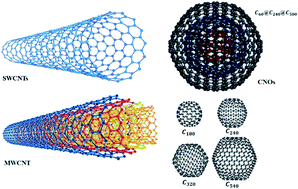Carbon nanotubes: functionalisation and their application in chemical sensors
Abstract
Carbon nanotubes (CNTs) have been recognised as a promising material in a wide range of applications, from safety to energy-related devices. However, poor solubility in aqueous and organic solvents has hindered the utilisation and applications of carbon nanotubes. As studies progressed, the methodology for CNTs dispersion was established. The current state of research in CNTs either single wall or multiwall/polymer nanocomposites has been reviewed in context with the various types of functionalisation presently employed. Functionalised CNTs have been playing an increasingly central role in the research, development, and application of carbon nanotube-based nanomaterials and systems. The extremely high surface-to-volume ratio, geometry, and hollow structure of nanomaterials are ideal for the adsorption of gas molecules. This offers great potential applications, such as in gas sensor devices working at room temperature. Particularly, the advent of CNTs has fuelled the invention of CNT-based gas sensors which are very sensitive to the surrounding environment. The presence of O2, NH3, NO2 gases and many other chemicals and molecules can either donate or accept electrons, resulting in an alteration of the overall conductivity. Such properties make CNTs ideal for nano-scale gas-sensing materials. Conductive-based devices have already been demonstrated as gas sensors. However, CNTs still have certain limitations for gas sensor application, such as a long recovery time, limited gas detection, and weakness to humidity and other gases. Therefore, the nanocomposites of interest consisting of polymer and CNTs have received a great deal of attention for gas-sensing application due to higher sensitivity over a wide range of gas concentrations at room temperature compared to only using CNTs and the polymer of interest separately.

- This article is part of the themed collection: 2020 Reviews in RSC Advances


 Please wait while we load your content...
Please wait while we load your content...